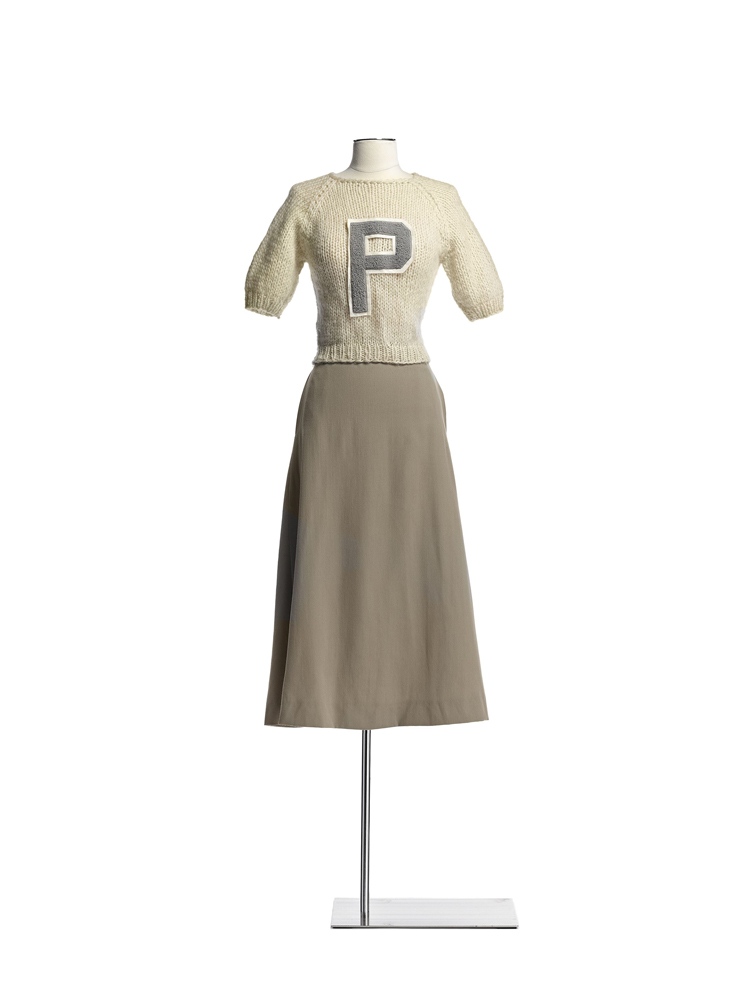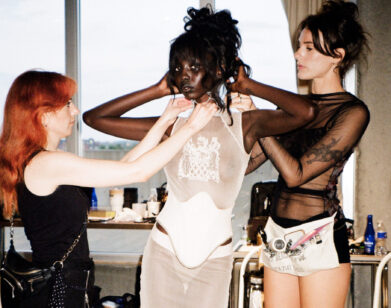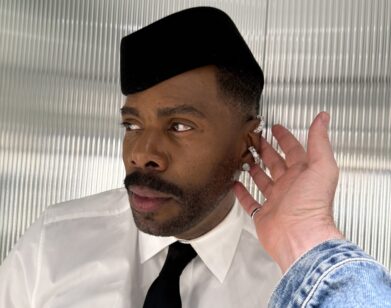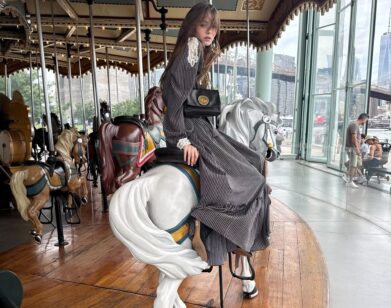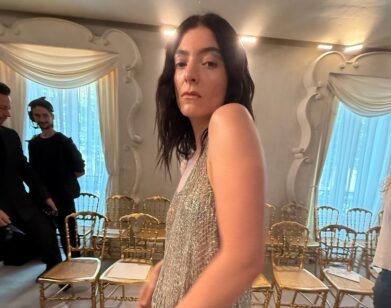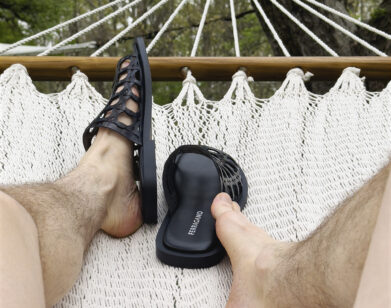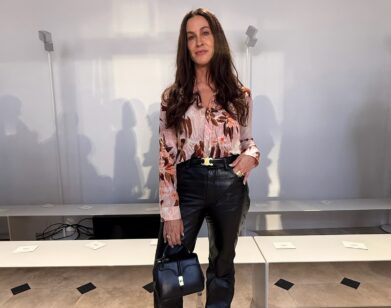Perry Ellis and American Prep
Cropped crewneck sweaters are a sportswear staple that emerged decades ago. One of Perry Ellis’ signature pieces from his Fall/Winter 1978 collection is a cream-colored crewneck sweater with cable-knit shoulder details, three-quarter-length sleeves, and a gray, oversized varsity letter “P” emblazoned on the front. When paired with his khaki gabardine pleated skirt, it’s difficult to imagine anything more preppy. But for iconic American designer Perry Ellis, the term preppy included much more than khakis and sweaters. Ellis expanded the notion of sportswear and surprised the fashion elite with his talents year after year. In spite of his substantial influence, until now, no one had compiled a comprehensive book or archive of Ellis’ work.
Last week, the CFDA and Parsons celebrated the launch of the 288-page monograph Perry Ellis: An American Original (Rizzoli), which was co-authored by Jeffrey Banks, Erica Lennard, and Doria de la Chapelle. “It all started with the last book that I did, which was called Preppy: Cultivating Ivy Style,” American designer, author, and COTY award winner Jeffrey Banks told us. “When we were doing that book I said, ‘We have to have a couple of Perry’s clothes because nobody was more preppy than Perry,’ but I couldn’t find pictures… I was shocked that no one had done a book before.” And with that, the idea of An American Original entered Banks’ mind.
After receiving a recommendation to contact Perry’s almost-exclusive photographer Erica Lennard for photographs, Banks gained access to the archival material he needed. “I save all of my archives, but the Perry Ellis work I always saved in a very special place,” Lennard says. Lennard had saved everything—every outtake, every original photograph, and every ad campaign.
“She didn’t have it all in the most organized way, but she had them,” Banks recalls while laughing. After three eight-hour days of sorting through archival material, Banks and Lennard decided to work together. “I really wanted to honor Perry’s memory,” Banks says.
The book chronicles Perry’s personal life and friendships as well as his creative process and collections. The latter half of the monograph provides an overview of each one of Ellis’ collections from the beginning of his career until his death, providing pictures, sketches, and descriptions. “I think it’s really important for young people to understand who he was and to learn from him,” Lennard explains. “There is so much information for both students of fashion and people who love fashion.”
More than just books, the launch party also included an exclusive one-night exhibition of 69 original garments honoring Ellis’ legacy. His cheerleader sweater and khaki skirt stood alongside a linen, tropical print “Espana” skirt, thick striped shrug, and taupe blouse cinched with a wide brown leather belt. Drop waists appeared opposite empire-line dresses; classic plaids were placed beside bold prints. However, while Ellis’ elegant evening gowns and a wedding dress naturally assumed center stage, very few of his menswear pieces were on view. Ellis’ menswear career was short lived (he began designing for men only six years prior to his death), but even still, only 10 menswear looks appeared—one of which was Perry’s personal khakis and signature blue shirt.
We spoke with Banks about his relationship with Ellis before guests, such as Diane Von Furstenberg, Isaac Mizrahi, Bill Cunningham, and Ellis’ daughter Tyler Ellis, arrived.
EMILY MCDERMOTT: I know you worked for Ralph Lauren and Calvin Klein, but how did you meet Perry?
JEFFREY BANKS: I met Perry over a backyard barbeque. I was at a barbeque in New York, and his backyard butted up against the back of it. He was emptying his garbage, and my friend said, “Oh Perry, come over and meet our friend Jeffrey.” That’s literally how we met, right at the onset of both of our careers.
MCDERMOTT: How would you describe him and your friendship?
BANKS: We were good friends. Perry loved to eat. I like to cook. [laughs] Perry would call me and say, “Could you come over and make so-and-so?” It was a great friendship. I went to every single show for 10 years. I never missed a show. So seeing all of these clothes again is amazing, really amazing.
MCDERMOTT: Do you have a favorite collection?
BANKS: My favorite collection is the Sonia Delaunay collection, which was not well received by the press, but I thought it was the most brilliant thing he ever did. I thought it was incredible color choices and fabrics. I just thought it was sensational.
MCDERMOTT: Definitely. I loved the photographs on page 50 and 51 of the book—the woman in the mink coat opposite the sketches for the look she was wearing. I know you are well known for your furs, but do you have a favorite fur women’s look that Perry did?
BANKS: I was the one who told Perry, when he said he wanted to do furs… I said, “Well you have to come to Alixandre who does my furs because they do the best furs.” So I made that marriage for him. We also show two pictures in the book of the Delaunay fur. The idea that you could do all of those different colors and all of those different pieces, it was really a technical feat to do a fur like that. Nobody had thought of that. He did plaid furs in the collection, with the tartan plaid. No one had ever done that. Everyone said, “It’s impossible. You can’t do it,” which only made him more determined to do it.
MCDERMOTT: Do you have a section of the book that you remember—
BANKS: My favorite section of the book is called “Perry and His World,” because I knew a lot of his friends. Finding all of those personal pictures, I think, always makes a book special.
MCDERMOTT: Yeah, especially the personal memoirs that people wrote. Was there a surprising moment during the research? A moment where you were shocked by something that you found?
BANKS: Not really, because I did know him very well. I think what came home to roost more and more was how focused he was. I knew he was focused, but he was really focused. When he wanted something, there was nothing other than getting his way. Perry didn’t take no for an answer. He just didn’t. The showroom that they spent almost $6 million doing in 1980—that almost put Manhattan Industries out of business. Larry Lee, the head of Manhattan Industries, kept saying to Perry, “We can’t afford this,” and Perry would not be deterred. He said, “This is what I want, and you will build it for me.” And he got it. [laughs]
MCDERMOTT: That’s incredible. After his death in 1986, which is where the book finishes, do you think the brand shifted?
BANKS: Yes, I think it did. It went through several different ownerships. I think the current ownership of the company is looking to try to recapture all of the things that made Perry Ellis successful in the beginning, and I think that’s a good thing. They’re trying to go back to all of the things that made him special—the dimple sleeve, the pin-point oxford shirt, khaki pants. All of those things are essentials.
MCDERMOTT: If Perry were alive today, what do you think he would say about his brand or if there were a change he could make, what would it be?
BANKS: I think the biggest change for Perry, if he were alive today, would be that he would want to do more than just clothes. I know he would want to do more than just clothes. He’d want to do home, he’d want to do cards, because he was curious. He was a curious guy. He had a lot of interests.
PERRY ELLIS: AN AMERICA ORIGINAL COMES OUT TOMORROW, OCTOBER 22. FOR MORE INFORMATION OR TO PURCHASE THE BOOK, VISIT THE RIZZOLI WEBSITE.

